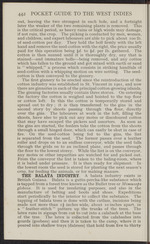| 1 |
 |
“...including the valuable!
greenheart, mora, wallaba, crab-wood and red cedar, etc!
British Guiana greenheart (Nectandra Rodiasi) has been largely)
used for the locks, etc., on the Manchester Ship Canal and more»
recently on the Panama Canal. Mora (Dimorphandra mora) is!
principally used for railway sleepers, while Wallaba (Eperua spp.)
is exported for telephone poles and as fuel to the islands. Thai
collection of balata from the tree known as Mimusops globosa1
forms an important industry. This gutta-percha-like substanc®
is largely used for insulating purposes and in the manufacture
of belting.
CLIMATE. The climate of British Guiana compares favour*
ably with that of other tropical countries. The temperature
is uniform, rarely rising above 920 Fahr. or falling below 751
Fahr. The mean annual temperature of Georgetown is 821
Fahr., and the average rainfall of the colony about 90 inches.;
On the high lands in the interior the chmate is not unlike that
of British East Africa. The long rainy season...”
|
|
| 2 |
 |
“...on to an inclined plane, and passes through
the floor to the lowest storey. While the lint is on the conveyor,
any motes or other impurities are watched for and picked out.
From the conveyor the lint is taken to the baling-room, where
it is baled under pressure. It is then ready for shipment. In
the lowest room the seed is stored for planting the next season's
crop, for feeding the animals, or for making manure.
THE BALATA INDUSTRY. A balata industry exists in
British Guiana. Balata is a gutta-percha-like substance which
is tapped from a forest tree known as the Bullet tree or Mimusops
globosa. It is used for insulating purposes, and also in the
manufacture of belting and boots and shoes. Expeditions
start periodically to the interior to collect the substance. The
tapping of balata trees is done with the cutlass, incisions being
made not more than i£ inches wide, about 10 inches apart, in
a “ feather-stitch ” pattern up the trunks of the trees. The
latex runs in zigzags from cut to cut into...”
|
|
